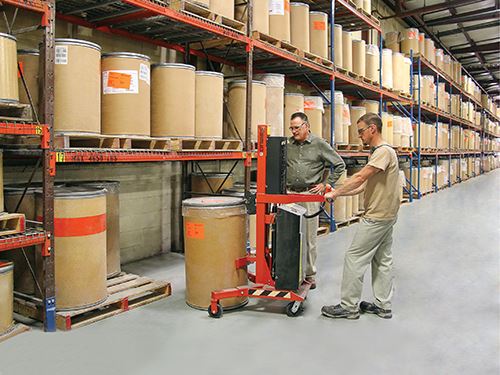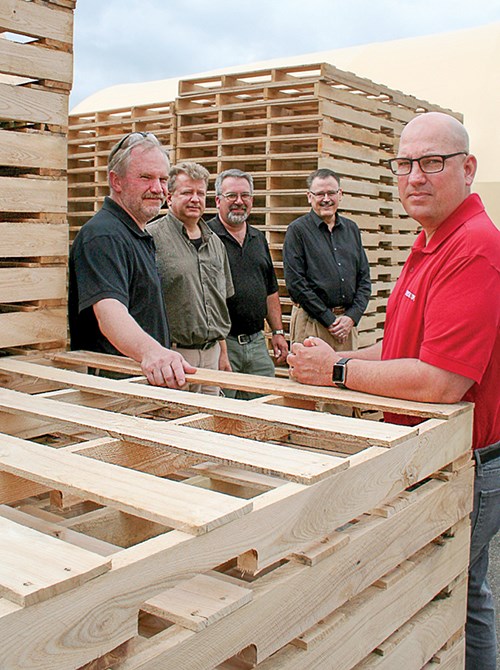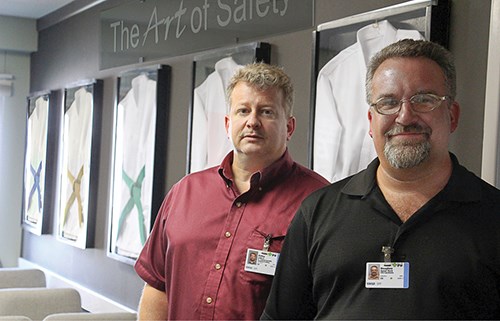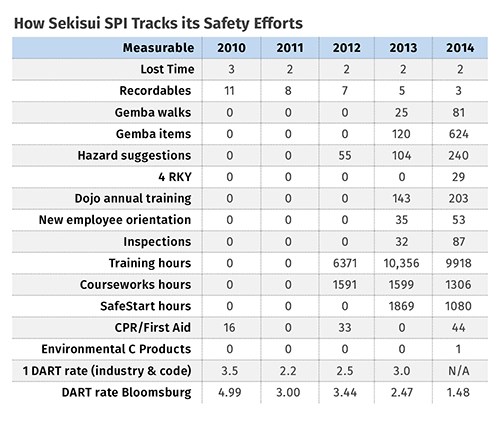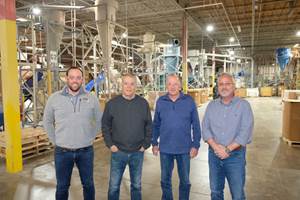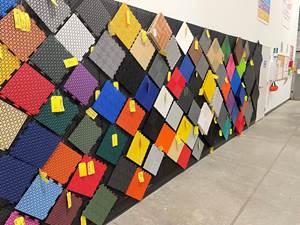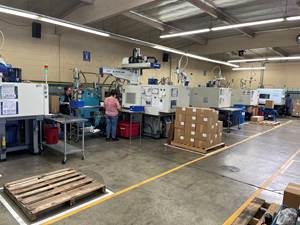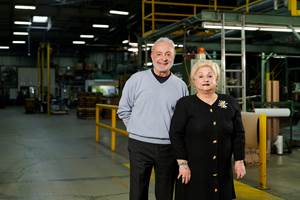At This Sheet Manufacturer, It's Safety First...At Any Cost
Sekisui SPI is an innovative manufacturer of highly engineered, customized thermoplastic sheet. And every pound of it is produced in a ‘safety first’ environment.
There’s as much safety built into every sheet produced by Sekisui Polymer Innovations (SPI) LLC as there is polymer. At this leading supplier of industrial sheet for applications that include mass transit, aviation, medical, signage, electronics, agriculture, and industrial equipment, terms like training Dojo, Gemba walks, and Kiken Yochi are used as least as often as output rate and lead times.
Sekisui SPI is part of Sekisui Chemical Co. Ltd., an $11 billion global company that supplies a wide range of polymers and polyolefin foaming technologies. The sheet extruder has three plants in the U.S.: two in Bloomsburg, Pa., and a third in Holland, Mich. To many, the company might be more recognizable as Kydex or Allen Extruders. Sekisui Chemical purchased Kydex in 1987, when the former was known as Kleerdex. Sekisui bought Allen in 2007. Last fall, Kydex and Allen were brought together as Sekisui SPI. Kydex and Allen live on as brand names within the Sekisui SPI product portfolio.
This past February, Sekisui SPI bought a 375,000 ft² facility on 56 acres in Bloomsburg, located two miles from company headquarters. At the HQ location, Sekisui SPI employs about 200 people, runs four shifts on an every-day, around-the-clock basis, operates six twin-screw extrusion lines for processing powdered PVC into sheet, and a seventh line to produce PC sheet. About 90% of its extruded sheet is cut to length.
Sekisui SPI specializes in short runs of about 600 lb. “Our average lead time is 12 days,” remarks Ronn Cort, Sekisui SPI COO and president. “We keep very little in-stock inventory. Our goal is to be able to fill an order of sheet in any color in five days.”
The company has grown of late as a result of increased exports. Between 2005 and 2010, Sekisui SPI increased its export sales from 3% to 50% of its overall business. States Cort: “We stopped trying to be all things to all people. Data showed that the middle class was not strong in the U.S. But people in other parts of the world are building more trains, planes, hospitals, etc. And as these emerging markets grew, we were there. We don’t buy from China, we sell to China.”
Meeting these growing needs requires capacity. “In 2012, we were producing 16 million lb/yr and figured our (Bloomsburg) capacity would be tapped at 17 million lb,” Cort recalls. “But in 2015, we bumped our capacity to 20 million lb, and we accomplished this without changing or adding a single piece of new equipment.” That achievement, Cort says, came as the result of “looking at 100 different things, and trying to increase the efficiency of each by 1%.”
Sekisui SPI is completely in the business of highly engineered, custom-developed sheet. And it supports this “boutique niche,” as Cort puts it, with a lot of R&D. Since 2012, some 6000 ft² of the company’s 160,000 ft² Bloomsburg plant has been devoted to the manufacturer’s designLab (a name it has trademarked), which features fully equipped labs for color development and R&D, as well as areas for meetings and collaborative working. Close collaboration with customers on developing new products has always been the core of the company’s brand promise, notes Bernadette Chupela, customer collaboration manager.
In May of last year, Sekisui SPI added a materials testing facility, called FSTLab, in Bloomsburg. The term “FST” refers to flame, smoke development, material toxicity, and heat-release testing. At the facility, engineers, processors (mostly thermoformers), and end users collaborate with Sekisui SPI’s R&D and design teams on new fire-resistant technologies and materials; and Sekisui SPI’s engineers perform regulatory tests on products throughout the development cycle. The FSTLab includes collaboration areas and six testing laboratories.
This spring, at the annual Aircraft Interiors Expo in Hamburg, Germany, Sekisui SPI introduced “breakthrough” technology that permits patterns to be produced directly in the sheet. Called Infused Imaging, this technology eliminates the need to apply a decorative cap layer to achieve bespoke patterns and designs. The new technology can be applied across the company’s product lines and industries that it serves.
States Cort: “We are an early-adopter technology provider. We define ‘innovation’ as allowing customers to do what they never would have thought was possible in the first place. In aviation, decades-old technology like press lamination, application of decorative film caps, and ‘bonded buildups’ all create challenges for the seating and interiors manufacturers.
“Now, customized, integral patterns and bespoke artwork created by the client can be used throughout the cabin as part of a design concept, which becomes part of the company’s brand, far beyond a name or color. It’s the ultimate in customization and part of SPI’s commitment to continuous improvements in customer collaboration, quality, innovation, design, and color. No more ‘last-minute design compromises’ due to deformed designs, cap delamination, or burn-test failure because of multi-layer construction. This new technology means the design is the polymer.”
SAFETY RULES THE DAY
Its innovation in materials formulation and development, product design, and processing notwithstanding, Sekisui SPI is a safety-first business. If you have any doubts, consider that any employee has the authority to shut down a line at any time if the employee encounters what feels like an unsafe condition. “Our least favorite words are ‘I knew that was going to happen,’” Cort states. Under the direction of the company’s EHS team (Environmental Health and Safety), Sekisui SPI has worked over the last five years to create a culture where, simply, “people look after each other.”
Creating this culture requires time, effort, real estate, and money. Time and effort in the way of encouraging employees and their managers to take regular walks around the plant—and the office, for that matter—to identify possible safety issues and make suggestions as to how they can be rectified. Effort (and real estate) to engage employees in regular training at the manufacturer’s training Dojo. And money? This commitment does not come without a price, but Sekisui SPI considers that irrelevant.
“I once spoke to a group of students at a business school, and I asked how many of them planned to work in manufacturing,” says Cort. “Three hands were raised. Why? Because everyone there had a father or grandfather who told them horror stories and maybe had injuries because they worked in an unsafe environment. Most manufacturing companies respond to this by saying, ‘We’ll get OSHA certification.’ But is that enough? No. Here, safety means trust. It means the employees who work here and the families they support know that I have their back. I can’t tell employees to take care of the customer if we are not doing everything possible to take care of them. If I’m leading this effort at all, it’s from behind, being pulled by the employees who are as deeply committed to safety as any manager or executive.”
Much of Sekisui SPI’s safety program is rooted in Japanese culture. It calls the safety walk-arounds Gemba walks, a Japanese term that translates to “the work place.” The Dojo (training facility for martial arts), whose walls are adorned with Karate gis (robes) and belts of various colors, was built shortly after Cort took over as president/COO in 2012. He recalls, “We reached out to Sekisui’s safety department in Japan to find out from our corporate ownership which of our sister companies had the best safety training. We visited two. One thing we noticed is that in both places, no one is in charge of safety. Everyone is in charge of safety. We went through the training Dojo. We worked to understand the process.”
Adds Colin Kelley, EHS senior training specialist “To us, nothing matters more than safety. But it took time for us to build safety into the culture. We started with companywide, monthly Sekisui Safety Matters meetings. After nine months, things started to turn when an operator raised his hand to complain about the jig saws being used in the plant.” Recalls Aaron Douglass EHS coordinator, “He said, ‘They work fine, but they could have more safety features.’ Our response to him was, ‘Help us find one that’s safer.’ He got engaged in the process, selected the safest jig saw available, and we bought one for each line.”
Compliance with OSHA regulations is one part of Sekisui SPI’s four-pronged safety program. Another part is what the manufacturer calls “peer to peer,” where employees are encouraged to alert their colleagues of a potential hazard. “An employee might go outside on break to have a smoke, then come in the plant afterward with his safety glasses on top of his head,” says Tom Kapelewski, EHS manager. “Our culture now is that another employee will notice, point to his head, and say, ‘Glasses.’” Another component of the program is what the company calls “The Art of Safety.” States Kelley, “An important element of what we are trying to do is to create a system where everyone will be trained to be a trainer.” Safety at Sekisui SPI is always evolving. “No one goes to school and graduates with a
degree in safety, so we had to develop the tools,” says Dave Hebda, plant manager, “We also benchmark other companies. We recently visited a carpet manufacturer to learn specifically about forklift tires.”
The Gemba walks generally create action items. In 2014, Sekisui SPI resolved 91% of the issues brought to the attention of the EHS. These covered a wide range of matters, from an extension cord plugged into a place where it could cause someone to trip, or tools being out of place, to grease on the floor or an unclean work area. Employee involvement in the Gemba walks does not end with them spotting an issue. Instead, they are “championed” with collecting whatever information is necessary to explain the problem in detail, and to help develop a solution.
Sometimes these solutions cost money, and according to Douglass, the sheet extruder’s executive team has yet to turn thumbs down on any request. “It’s part of the culture,” Tom Kapelewski, EHS manager, adds. “There’s never been a capital expenditure for safety that’s been refused.” The company invested $250,000 on customized equipment in its masterbatch area to address an issue with dust formation, and another $650,000 on new fire-suppression systems for the material bins. In another case, recalls Douglass,
“An employee was having problems completely emptying gaylords during the process. He concluded that if he could have something that could tilt, he’d get easy access to material. He did the research at home in his free time, and brought the idea to us. We now use this system in both our production and granulation area.”
Classroom and online training has always been a part of the company’s safety program.
In 2013, the company invested in company-wide classroom training with SafeStart, a training program developed by Electrolab Training Systems in Canada. Sekisui SPI chose the program because it emphasizes creating a safety mindset at work, on the road, and at home. To date, 185 employees have logged more than 3000 hr since the program began.
Sekisui SPI also practices the Japanese Kiken Yochi (hazard-anticipation process, called 4RKY), in which potentially dangerous issues are anticipated during four rounds of analysis and resolved before an incident occurs. “The four rounds consist of identifying the potential issue; noting the top two hazards the issue poses; developing countermeasures to solve these hazards; and voting on the two top countermeasures to solve the two top hazards,” Kelley explains.
Sekisui SPI put this practice to test recently. Typically, the company used hand trucks to move barrels of pigment and powder from storage to production. This meant the barrels had to be handled by the employees frequently to keep them stable in transit, and usually had to be lifted for positioning on the weigh scale. “Anticipating a potential injury or spillage, we now move material with barrel lifters that are attached to tuggers,” states Douglass.
Sekisui SPI also has an employee safety-suggestion program. Each Friday the EHS team reviews that week’s suggestions, with a champion being assigned to each open item. It also launched a Safety Bucks Program, whereby employees accrue “Safety Bucks” for prizes, depending on their involvement in various aspects of the safety program. It also has a monthly safety contest that encourages and rewards employees for making any suggestion to improve safety. “Recently one employee came up with 28 different suggestions for safety,” states Kelley. “He found 28 different issues, ranging from frayed electrical wires to opportunities to post new signs to indicate hazards and pinch points.”
Cort credits much of the output gains mentioned earlier to safety. “By focusing on safety and not just speed, our employees came up with better methods to improve die and roll changes, which had the unintended impact of improving efficiency.” Still, to Cort, quantifying Sekisui SPI’s safety initiatives in dollars and cents misses the point. “How do we become one of those companies that the millennials want to work for?” he aks. “It starts with safety, with creating a culture that encourages and rewards initiative.”
Related Content
Evolving Opportunities for Ambitious Plastics Recycler
St. Joseph Plastics grew from a simple grinding operation and now pursues growing markets in recycled PP, food-grade recycled materials, and customized post-industrial and post-consumer compounds.
Read MoreInjection Molder Bases Company Culture on Employee Empowerment
After more than two decades in the industry, Rodney Davenport was given the opportunity to create an injection molding operation in his own vision, and — in keeping with the product he was making — to do so from the ground up.
Read MoreBack in the Family Business
In its 45th year, Precision Molded Plastics has carved out a technology and market niche, growing not just when opportunities arise but when they make sense, after its leader changed careers to keep the family business from changing hands.
Read MoreGeneration Gap? Not at Packaging Personified
Started at a kitchen table and now in its third-generation of family involvement, this vertically integrated supplier of flexible packaging traces its success to closely aligning with customers and continually investing in new technology across its films, printing and converting operations.
Read MoreRead Next
For PLASTICS' CEO Seaholm, NPE to Shine Light on Sustainability Successes
With advocacy, communication and sustainability as three main pillars, Seaholm leads a trade association to NPE that ‘is more active today than we have ever been.’
Read MoreSee Recyclers Close the Loop on Trade Show Production Scrap at NPE2024
A collaboration between show organizer PLASTICS, recycler CPR and size reduction experts WEIMA and Conair recovered and recycled all production scrap at NPE2024.
Read More

